Originating in the snow-capped Rocky Mountains of Colorado and Wyoming, this majestic river flows through seven states, serving multiple purposes for millions of people. It nurtures ecosystems through agriculture, drinking water production, and hydroelectric power generation. Spanning roughly 1,450 miles, many have concerns about whether swimming in the Colorado River is safe.
Our extensive research offers a conclusive response to this query. Join us as we examine the characteristics of the river, possible swimming dangers, and essential safety precautions to ensure your safety while enjoying this famous waterway. Let’s begin straight away!
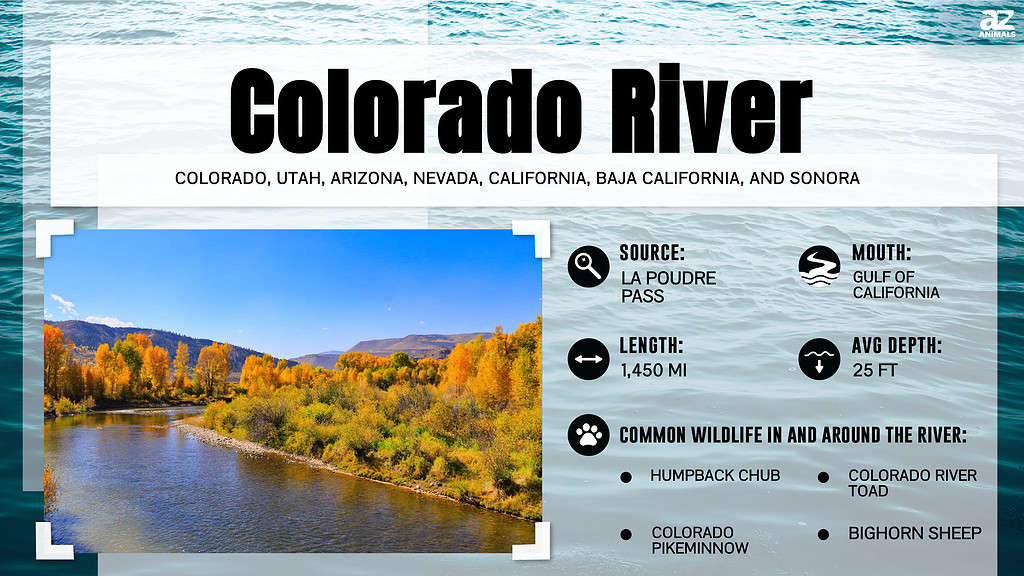
Composition of the Colorado River
The composition of this unique river determines your safety while in the waters. Colorado is made up of various water sources, encompassing natural elements as well as human-induced pollution. Let’s take a journey into its composition to help you understand better.
Overview of the River’s Water Sources
Renowned as the “Lifeline of the Southwest,” the Colorado River’s primary water source is the melting snow from the Rocky Mountains. However, it replenishes and enriches its composition from tributaries like the Green and Gunnison Rivers.
Other rivers include San Juan, Dolores, Gilla, and Little Colorado from the east. Escalante and Dirty Devil are from the west, while Kanab, Paria, and Virgin Rivers are from the north.
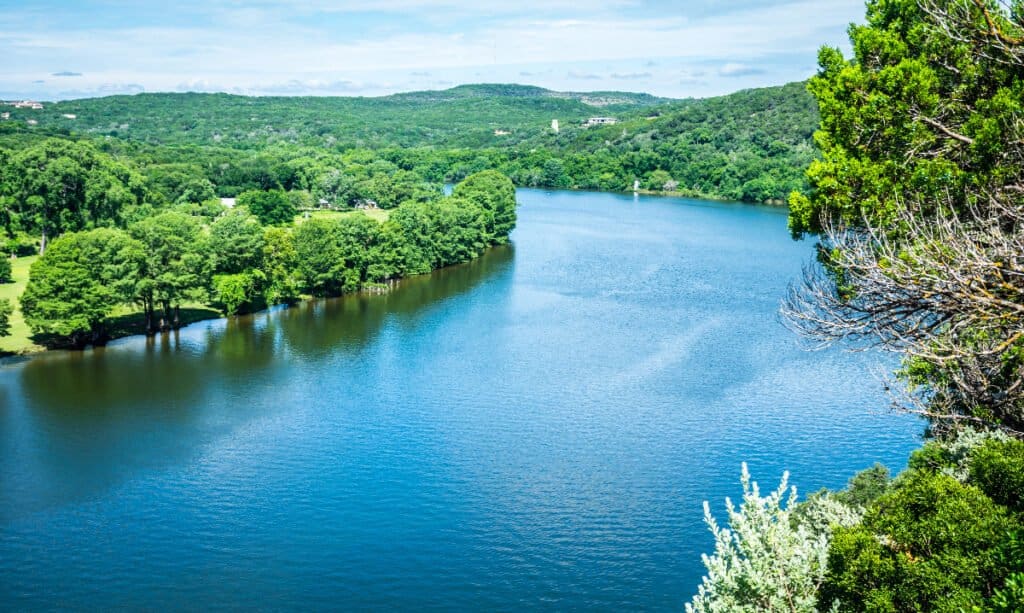
The Colorado River begins with a variety of sources, including Rocky Mountain snowmelt and desert runoff. Together, these waters form the powerful river that flows through seven U.S. states before reaching the Sea of Cortez in Mexico.
©Roschetzky Photography/Shutterstock.com
Natural Components Present in the River
The Colorado River has several natural components which give the river unique characteristics. As the river flows through the Rocky Mountains, it carries sediments, minerals, and organic matter. These elements play a vital role in the ecosystem. They also support the survival of various flora and fauna that depend on the river.
The composition of the sediments, from rocks and minerals to tiny particles like clay and silt, varies depending on the area’s geology and human activities where the river passes through.
The Colorado River has been instrumental in shaping the landscape it meanders through, with its sedimentation processes and geology leaving a lasting impact. This iconic river has played a significant role in forming geological wonders such as the renowned Grand Canyon, showcasing the dynamic changes and formation of riverbanks over time.
With breathtaking canyons and exhilarating whitewater rapids, the Colorado River offers myriad opportunities for outdoor enthusiasts. One such notable feature is the Horseshoe Bend. This is a salient, horseshoe-shaped rock formation nestled within the river’s path. This captivating natural feature provides an idyllic setting for a range of recreational water activities, earning the Colorado River a well-deserved reputation as the “Granddaddy of rafting trips.”
Human-Made Pollutants and Contaminants
Pollution poses a significant challenge to water bodies, and the Colorado River is no exception. Despite its vital role in supporting communities and ecosystems, the river faces contamination from both human activities and natural processes. These factors contribute to the presence of pollutants in the river’s system, necessitating the imminent need to ensure its preservation and health.
Therefore, before swimming in the Colorado River, be mindful of certain risks due to pollution. Some of the potential risks related to the river are:
Agricultural Runoff
The Colorado River’s health and quality are severely hampered by agricultural runoff. The river is susceptible to the introduction of numerous contaminants from agricultural activities because it is one of the main water sources for irrigation in the area.
Water quality and ecosystem balance may suffer if extra water from fields that are also carrying sediment, fertilizer, pesticides, and other contaminants spills into a river. The sediment runoff can cloud the water, reducing light penetration and impacting aquatic plants and organisms. The fertilizers and pesticides can contribute to nutrient pollution and algal blooms, leading to oxygen depletion and harm to aquatic life.
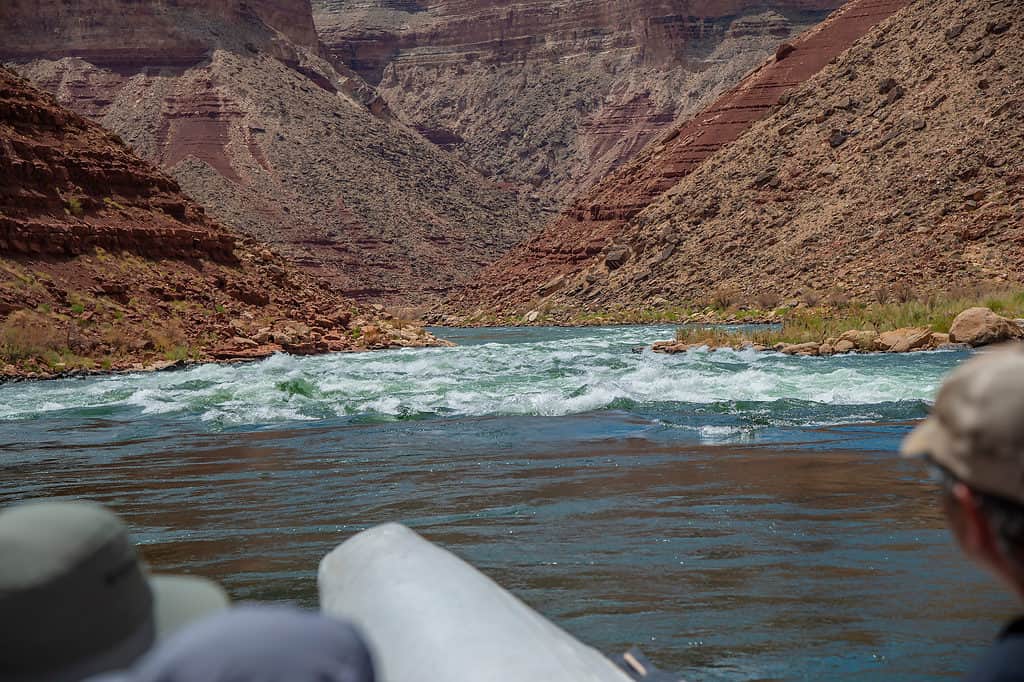
Pollution from farms and ranches can include sediment, fertilizers, pesticides, and other contaminants that make their way into the water supply.
©William Eugene Dummitt/Shutterstock.com
Industrial Discharges
Industrial discharges into the Colorado River raise serious issues with regard to ecosystem health and water quality. Industrial processes such as manufacturing, mining, and power generating introduce a variety of contaminants into the river water. These include heavy metals, chemicals, organic compounds, and thermal pollution.
These releases might lead to a buildup of poisons in the food chain, putting aquatic life and those who rely on the river for their water supply in jeopardy.
Sedimentation and Erosion
Sedimentation and erosion are naturally occurring processes in a river due to its flow. These introduce fine particles like clay and silt into the water. When these become excessive, they can have adverse effects on water clarity. Excessive sedimentation not only hampers visibility but also poses potential risks to the health and safety of swimmers.
Invasive Species
Invasive species in rivers are non-native plants, animals, or microorganisms. True to its name, these species are invasive, establish themselves, and spread rapidly. This causes harm to the native ecosystem. They lead to biodiversity loss and potential extinction of native species.
Invasive plants form dense mats on the water surface, blocking sunlight and reducing oxygen levels, negatively impacting aquatic plants and organisms. They can disrupt nutrient cycles, leading to algal blooms and water quality issues. Swimmers must be conscious in making sure they do not, intentionally or otherwise, introduce invasive species into the river ecosystem.
Aquatic Life
The Colorado River is home to an array of aquatic life. Some fish species it sustains are bass, catfish, black crappie, trout, and walleye. Despite the unique conditions of the Colorado River, the fish species have adapted.
Fish populations play a vital role in maintaining the overall health and balance of river ecosystems. They provide crucial ecological services by participating in nutrient-cycling processes and serving as a food source for various wildlife species. These fish stocks contribute to the overall biodiversity and stability of the river’s ecosystem.
In the upper part of the river basin, native fish species such as bonytail and Colorado pikeminnow can be found. While the Grand Canyon was once home to eight native fish species, only five now remain due to the river’s geographical isolation.
The remaining species include the bluehead sucker, humpback chub, flannelmouth sucker, razorback sucker, and speckled dace. These are, however, listed as endangered species. The decline in fish species is proof that we need to culminate our efforts to protect and restore the river’s unique biodiversity and ecological balance.
Animals
Besides fish, the river forms a critical habitat for many animals. Turtles, frogs, lizards, tortoises, toads, and geckos live in or around the water. The rabbits, deer, bighorn sheep, and elk come to the riverbanks.
In the river’s nearby trees is a home for beautiful songbirds and raptors flying in the sky. These include alder, eagles, goldfinches, falcons, flycatchers, and woodpeckers. In other areas, you may see bears, coyotes, foxes, raccoons, mountain lions, and wolves.
Many animals from the American West find habitat in wetlands and forests. Among these are the beavers building dams in and around parts of the Colorado River.
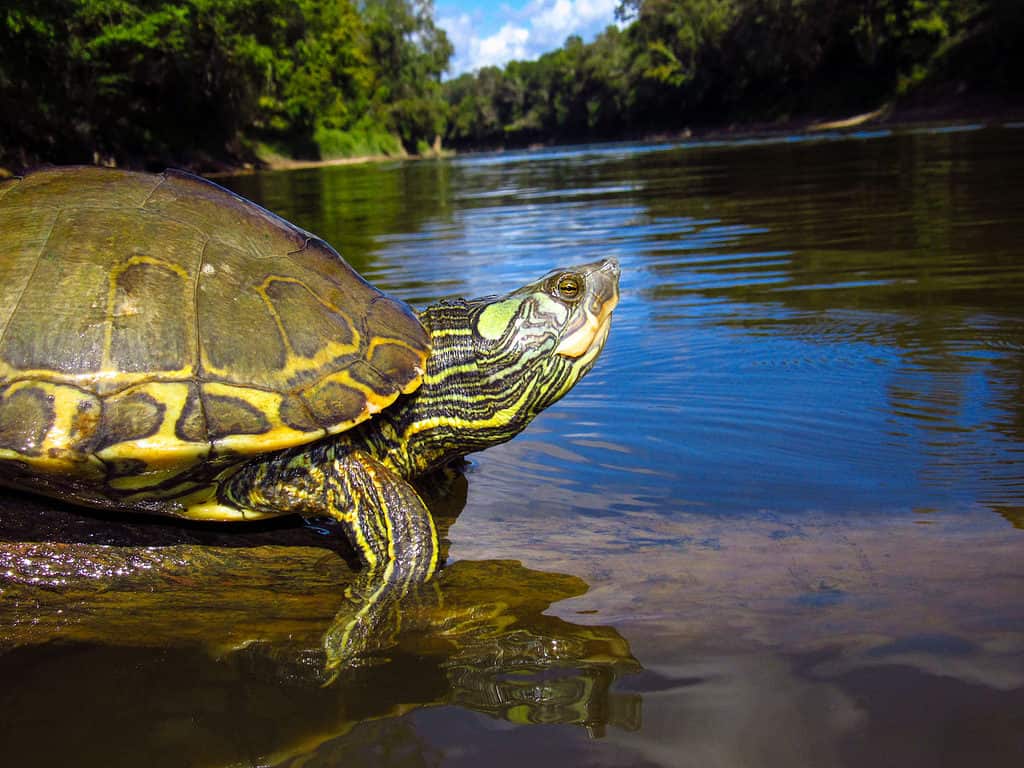
The wildlife that inhabits the Colorado River is incredibly diverse.
©Gabbie Berry/Shutterstock.com
Recreation and Tourism
The Colorado River attracts a vast number of visitors annually. The river has immense recreational opportunities and tourism. These contribute to the economic growth of its surroundings. Some activities found here include swimming, boating, fishing, and rafting.
Local authorities and environmental organizations have put in place monitoring efforts. They aim to balance recreational activities and the river’s ecological preservation. Safety guidelines and regulations implementation is crucial to guarantee visitors’ safety and happiness.
Hazards in the Colorado River
The Colorado River offers a variety of recreational activities. But, its natural setting poses possible hazards that you must consider as a swimmer.
Around the Colorado River are a variety of snakes. Among these are bullsnakes, gopher snakes, and multiple garter snakes. They play a significant role in the ecological balance and pose no harm.
Even so, refrain from provoking them to avoid danger, especially the rattlesnake. If you encounter a rattlesnake, gently back away and leave the area.
Other venomous creatures are lizards called Gila monsters, scorpions, and black widow spiders. Bites from them need immediate medical attention. Thus, be vigilant of your surroundings. Avoid tall grass and rocky spots where these animals love sheltering.
Is the Colorado River Safe for Swimming?
The Colorado River has breathtaking landscapes and recreational opportunities. However, swimming concerns arise about it. Swimming in the Colorado River takes place in designated areas like the River Island State Park. But before you plunge into the water, it is paramount to understand the risks and the safety measures.
Water Quality
The Colorado River is susceptible to various risks that can impact both its natural environment and those who interact with it. Various factors, such as agricultural runoff, industrial wastes, and urban pollutants, contribute to water quality alterations.
Also, sedimentation and erosion, as well as the introduction of invasive species, pose potential risks. Consult local authorities or environmental agencies for guidance before engaging in any water activities. Water reports provide valuable information, including swimming guidelines, recommendations, and warnings.
Swimming in the Grand Canyon is prohibited due to safety concerns. Heavy rainfall or high water flow at certain times accentuate the risk. While enjoying the river’s beauty and recreational opportunities, it’s our primary responsibility to remain aware of its potential risk. Ongoing environmental monitoring efforts aim to assess water quality and identify any underlying issues which may need attention.
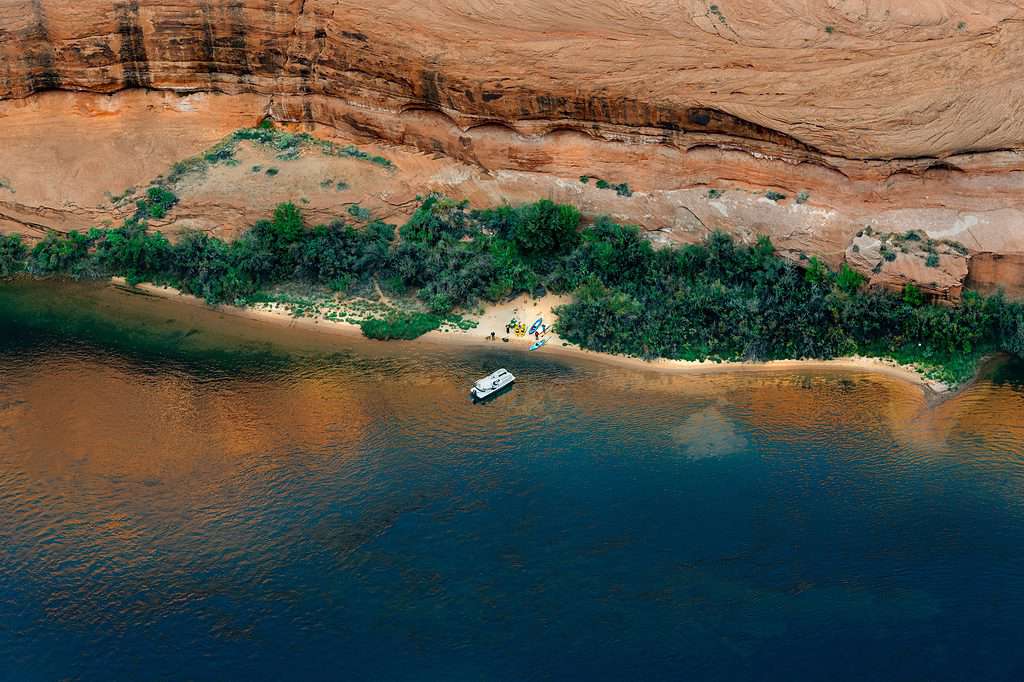
Despite cleanup efforts, this landmark river still faces many water quality problems that require further attention and action.
©HannaTor/Shutterstock.com
Personal Health
A personal health examination is vital before swimming in any body of water. Inherent risks like changes in water conditions, submerged objects, and swift currents can affect your health while in the water.
Thus, taking all the necessary measures to secure yourself is crucial. Pack your swimming gear when engaging in recreational activities on the Colorado River.
Local Laws
The local authorities have current information on the state of the water. Ensure you consult them and review the available water reports. They’ll offer the correct advice that can protect you from danger in areas you intend to swim. These efforts and safety guidelines can help mitigate the risks related to swimming.
Efforts are ongoing to manage and mitigate the Colorado River’s human impact. The government is formulating water management plans, conservation measures, and pollution control regulations. Once in place, they’ll safeguard the river’s health and ensure long-term sustainability.
Knowing Colorado’s composition and potential risks is vital for swimming enthusiasts. By making a responsible choice and taking appropriate precautions, you can safely enjoy the beauty of the Colorado River without compromising your health.
How To Stay Safe in The Colorado River
There are designated swimming spots if you’re considering swimming in the Colorado River. Make sure to check the official website for specific rules, safety guidelines, and operating hours of these designated spots.
Water in the Colorado River can be cold, specifically during the early summer months. Since the river originates from snowmelt, sudden immersion in its cold water can be extremely dangerous and potentially life-threatening. Even experienced swimmers should exercise caution. The risks of water gasping, inhaling water, and the onset of hypothermia are real concerns. Always prioritize your safety and be mindful of these risks when enjoying the river.
The river has sudden thunderstorms with strong winds accompanied by severe weather changes. These are some reasons you need to be cautious in this river. While you have fun on this unique river, your safety and that of others is vital.
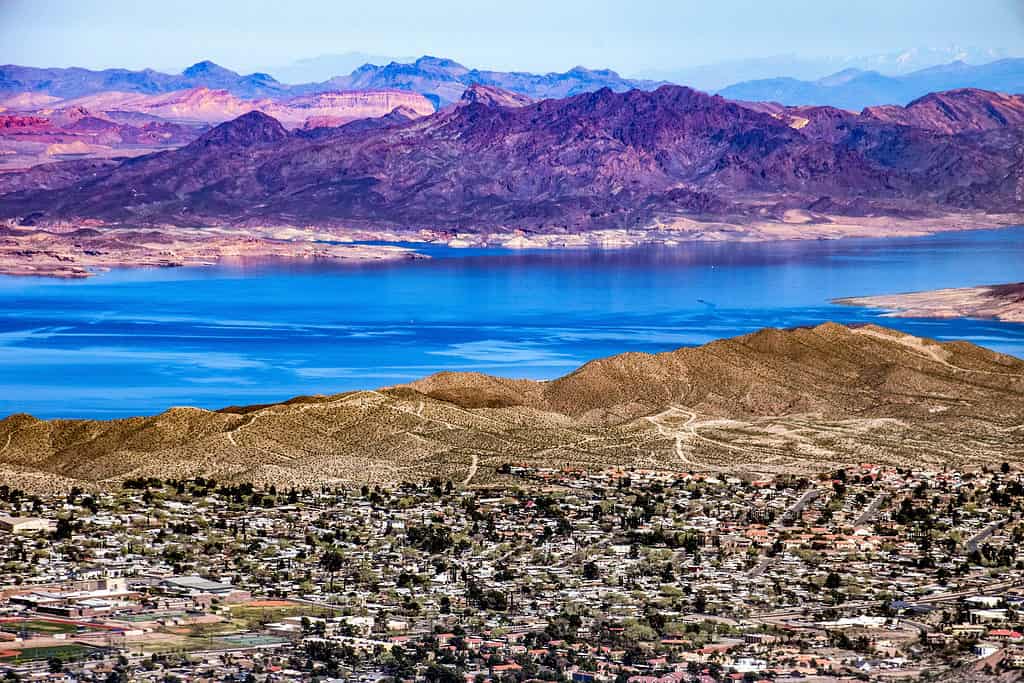
Be sure to wear appropriate clothing and equipment, such as a life jacket or flotation device, check the weather before heading out on the river, and never swim alone!
©iStock.com/Rodrigo A. Rodriguez Fuentes
Popular Swimming Spots in the Colorado River
The majestic Colorado River winds through awe-inspiring landscapes, offering fantastic swimming opportunities. The river has many swimming spots as it flows through seven states. But here are 2 of them and why they’re good swimming destinations.
1. Laughlin, Nevada
Situated along the banks of the Colorado River in Nevada. It is a charming resort town that offers a delightful escape for water enthusiasts. Laughlin gained popularity because of its pleasant climate and many recreational activities, making it a premier destination for swimming.
Laughlin offers visitors a chance to enjoy its refreshing waters and beautiful surroundings. Visitors can cool off and relax during the hot summer months in the designated swimming areas. Be it basking in the sun on the sandy beaches, taking a dip in the river, or engaging in water sports like kayaking and paddleboarding, Laughlin provides ample opportunities for aquatic fun.
Laughlin also caters to thrill-seekers with boating, jet skiing, and tubing opportunities, providing endless excitement and enjoyment.
2. Rotary Park
Rotary Park stands out as a favored destination for water-based recreation. It is in Bullhead City and boasts a designated swimming area with sandy beaches and calm waters. Rotary Park is ideal for families and individuals seeking a swim.
Its sandy beaches, calm waters, and scenic views make Rotary Park an attractive option for both locals and tourists looking to cool off and have fun in the river. The designated swimming areas with easy access to the water make it convenient for families, friends, and individuals to enjoy a leisurely swim or engage in water activities. The tranquil atmosphere and the convenience of park facilities make Rotary Park a popular choice. The majority find this spot ideal for unwinding and relishing the natural beauty of the Colorado River.
Balancing Enjoyment and Safety
The Colorado River is a majestic beauty of nature. It supports ecosystems and agriculture and offers myriad recreational activities to visitors. Swimming in the river is risky due to various reasons. Pollutants present in the river harm humans as well as the environment.
By taking necessary precautions and being responsible, we can all contribute to the preservation of the Colorado River and ensure enjoyment for generations to come. Keeping in mind the sustainability of the Colorado River, and the role we play in it, it is possible to have a good time and yet maintain the glory and beauty of the river for future generations to come.
So, dive in, have fun, and embrace the wonders of the Colorado River while keeping safety and sustainability in mind.
The photo featured at the top of this post is © Simon Morris / Flickr – License / Original
Thank you for reading! Have some feedback for us? Contact the AZ Animals editorial team.






